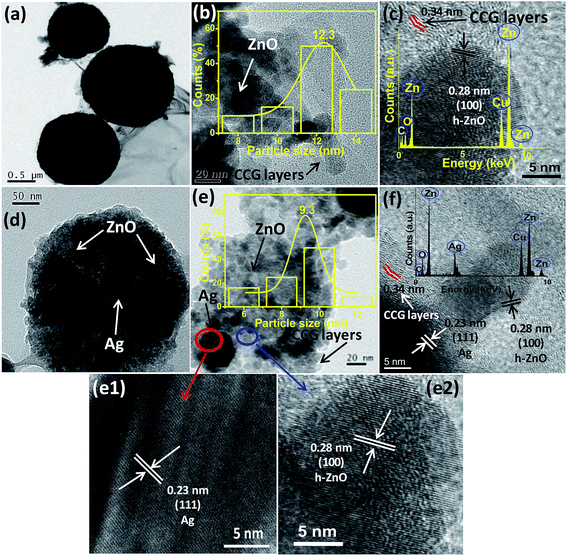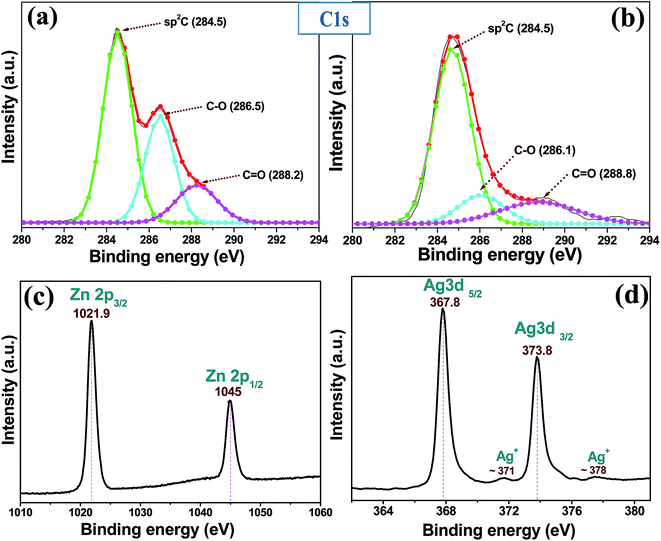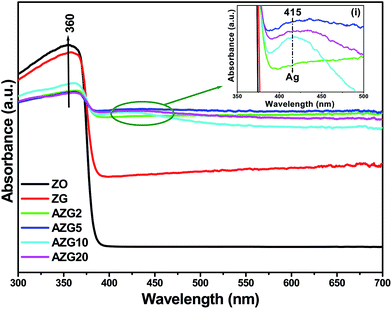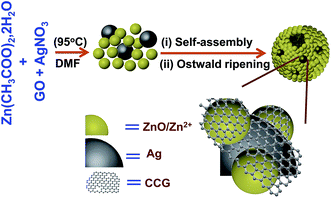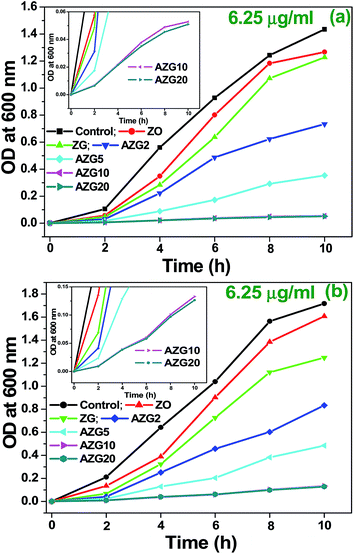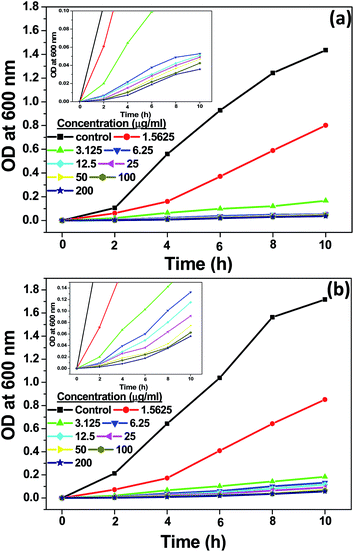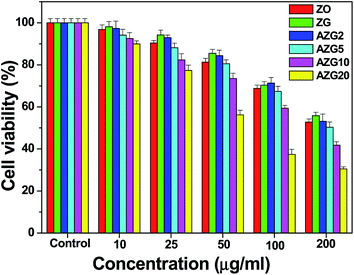Synthesis, characterization and antibacterial activity of Ag incorporated ZnO–graphene nanocomposites†
Atanu Naskara,
Susanta Beraa,
Rahul Bhattacharyab,
Pritam Sahac,
Sib Sankar Royb,
Tuhinadri Senc and
Sunirmal Jana*a
aSol-Gel Division, CSIR-Central Glass and Ceramic Research Institute, 196 Raja S.C. Mullick Road, P.O. Jadavpur University, Kolkata 700032, West Bengal, India. E-mail: sjana@cgcri.res.in; janasunirmal@hotmail.com; Fax: +91 33 2473 0957; Tel: +91 33 23223303
bCell Biology & Physiology Division, CSIR-Indian Institute of Chemical Biology, 4 Raja S.C. Mullick Road, P.O. Jadavpur University, Kolkata 700032, West Bengal, India
cDepartment of Pharmaceutical Technology, Jadavpur University, 188 Raja S.C. Mullick Road, Kolkata 700032, West Bengal, India
First published on 12th September 2016
Abstract
The present work reports on the successful one-pot surfactant-free in situ synthesis of silver incorporated ZnO–chemically converted graphene (CCG) nanocomposites (AZG) by adopting a low temperature solution technique from zinc acetate dihydrate, silver nitrate and graphene oxide, and the varying silver content (up to 20% Ag with respect to Zn) in the precursors. X-ray diffraction and transmission electron microscopy studies confirmed the presence of Ag and ZnO nanoparticles (NPs), distributed uniformly with CCG. FTIR, Raman, UV-visible and X-ray photoelectron spectroscopic analyses confirmed the existence of interaction between CCG with the inorganic moieties (ZnO/Zn2+ and Ag NPs) of the AZG samples. In vitro cytotoxicity and quantitative cell viability of the human ovarian teratocarcinoma cell line (PA1) was studied up to a maximum sample concentration of 200 μg ml−1. Antibacterial activity was also measured on E. coli and S. aureus to confirm the efficiency of the nanocomposite, especially for killing bacterial cells without any major effect on the surrounding cells. Among the nanocomposites, the 10% Ag incorporated sample at a 6.25 μg ml−1 dose showed excellent antibacterial activity with negligible cytotoxicity. This simple strategy could be applied in the synthesis of Ag incorporated different metal oxide–CCG nanohybrids for antibacterial applications.
1. Introduction
In the medical and food storage sectors, the rapid rise of multidrug resistant pathogens from the use of broad spectrum antibacterial drugs is a serious global problem.1 These pathogens are (e.g. bacteria, fungi) capable of surviving antimicrobials or antibiotics.2 According to the report of the World Health Organization, Escherichia coli (such as cephalosporins, fluoroquinolones), Staphylococcus aureus (methicillin), Hepatitis B virus (lamivudine) and Cryptococcus neoformans (fluconazole) are the most important examples of some kinds of microorganisms that have shown tremendous resistivity against their respective drugs.3 Moreover, repetitive use of antimicrobial drugs is also a worry due to different side effects in human beings.4 Most of the textile and fibre industries are also facing acute problems of microbial attack because of the use of antimicrobial fabrics in hospitals, hotels and restaurants.5,6 Hence, there is a great challenge towards providing an improved antimicrobial agent which could destroy the multidrug resistant pathogens safely and cost effectively.Nanocomposite materials could be used as nano weapons to tackle effectively the problem of multidrug resistant pathogens. Metal oxide nanoparticles have already been used in drug delivery,7 bio-imaging,8 antimicrobial activity9 etc. This is because the materials in nano dimension could easily enter into the living cells through the pores of plasma membrane proteins10 owning to high surface to volume ratio as well as physiochemical properties of nanomaterials. These could prove excellent protector against multidrug pathogens.11 The basic difference of antibiotics with nanocomposite materials consisting metal oxide is that the later prefer multiple target approach rather than mechanical approach of antibiotics12 and this could be a reason, why microbes fail to acquire resistance against nanocomposite materials. For this purpose, a wide variety of inorganic nanomaterials including copper oxide,13 zinc oxide,14 titanium oxide,15 gold16 and silver nanoparticles (NPs),16 graphene17 etc. had already been investigated explicitly. However, silver based nanocomposites had shown the most effective inhibitory properties against microorganisms including 16 major species of bacteria.18 In fact, Ag NPs are also known as an environmental friendly non-toxic material for biomedical applications.19
Among several metal oxide nanoparticles, zinc oxide (ZnO) is believed to be nontoxic, biocompatible and safe material [(21CFR182.8991) (FDA, 2011)]. Moreover, ZnO possesses a special ability to change/tailor a specific property of living cells in the biological system.20 Reduced graphene oxide (rGO)/chemically converted graphene (CCG) has also received strong attention due to unique physiochemical properties such as large surface area,8 easy to functionalize with other materials including metal oxides21 and high biocompatibility. The CCG also helps to perform antibacterial activity by disrupting bacterial cell membrane with the help of oxidative and membrane stresses generated by sharp edges of graphene nanosheets to kill bacteria.22,23
An improvement in antibacterial activity of the materials are possible by using cellulose nanocrystal,24–27 nanoparticles (NPs) of Ag and ZnO as well as graphene.9,12,28,29 The main disadvantage of cellulose nanocrystal is that it has no antimicrobial activity24 but it could show an improved antibacterial activity after coupling with ZnO24,25 and Ag NPs.26,27 Ag–ZnO nanocomposite also showed excellent antibacterial activity at 550 μg ml−1 and 60 μg ml−1 of nanocomposite for green fluorescent protein expressing antibiotic resistant E. coli and S. aureus, respectively.12 For poly(acrylonitrile/maleic acid)–silver nanocomposites, it was 25 μg ml−1 for Gram-negative (S. typhimurium, E. coli) and 50 μg ml−1 for Gram-positive (S. aureus, B. cereus) bacteria.28 The concentration required for complete bacterial inhibition growth is found to be 12.5 μg ml−1 of Ag–rGO nanocomposite for E. coli bacteria.29 A relatively high antibacterial activity with 10 μg ml−1 of ZnO–GO composite had also been reported for E. coli.9
The main problem with Ag NPs is it's stability.30 For the synthesis of stable Ag NPs, several techniques like sol–gel,31 laser ablation,32 sonochemical,33 electrochemical processes34 etc. could be adopted. Although, surfactants such as sodium borohydride,35 sodium citrate,36 hydrazine hydrate37 are mainly used in these processes to enhance the stability of silver NPs but it simultaneously weaken the antibacterial efficiency.29 Another problem of Ag NPs is its aggregation problem particularly in the nano size regime12 similar to ZnO21 which could be mitigated by coupling with CCG/rGO for the use in living cell system.38,39 Therefore, the challenge now stand is to synthesise stable Ag NPs–ZnO–rGO/CCG nanocomposite from surfactant free precursor solution technique, which could act effectively against bacteria without harming surrounding living cells.
The objective of the present work is to synthesize an effective nanocomposite having Ag, ZnO and CCG components for enhancing the antibacterial activity of the material due to the synergistic effect of the individual components. Herein, we report, a facile one pot surfactant free low temperature (95 °C) solution process for the synthesis of Ag–ZnO–CCG (AZG) nanocomposite using optimized contents of zinc acetate dihydrate, graphene oxide and silver nitrate as precursor materials. Gram-negative – Escherichia coli and Gram-positive – Staphylococcus aureus has been used to test the antibacterial activity and the human ovarian teratocarcinoma cell line (PA1) has been taken for the cytotoxicity study of AZG nanocomposite materials.
2. Experimental
2.1 Synthesis of Ag–ZnO–CCG (AZG) nanocomposites
For the preparation of graphene oxide (GO), modified Hummer's method was used.40 A facile low temperature (95 °C) solution process was adopted for the synthesis of Ag nanoparticle–ZnO–chemically converted graphene (AZG) nanocomposites. In this respect, the samples were prepared separately and in each preparation, a fixed amount (40 mg) of as-prepared GO was uniformly dispersed in dimethyl formamide (DMF, Merck) solvent (40 ml) by ultrasonication for about 2 h duration. In addition, a fixed quantity (1 g) of zinc acetate dihydrate [Zn(CH3COO)2·2H2O, Sigma-Aldrich, ≥98%] and silver nitrate (AgNO3, Qualigens, ≥99.9%) of different contents (0, 2, 5, 10 and 20 atomic percent, at%; with respect to Zn) was uniformly dispersed in 200 ml of DMF during continuous stirring. The products were designated as ZG, AZG2, AZG5, AZG10 and AZG20 where the content (at%) of Ag used in the precursors was 0, 2, 5, 10, and 20, respectively.Further, the GO dispersed DMF was mixed with zinc acetate and silver nitrate solution while stirring continuously for 2 h to form precursors of the nanocomposites. Subsequently, the precursors were kept in an air oven at 95 °C for 9 h.41 In this condition, the formation of Ag–ZnO–CCG (AZG) nanocomposites was observed from the change of colour (black to greyish white, ZG or yellowish white, AZG2, AZG5, AZG10 and AZG20) of the suspensions. The solid materials were then separated out by centrifugation using double distilled water and ethanol as washing solvents. Finally, the samples were dried in an air oven at ∼60 °C for 3 h. The same procedure was also followed for the synthesis of pristine ZnO nanoparticles (ZO) where no GO was used. It is worthy to mention that reduced graphene (rGO) could generally be formed due to reduction of GO via thermal annealing (>1000 °C),42 photochemical reduction43 and electrochemical reduction processes44 but in the present work, none of these processes was adopted and therefore, the presence of GO in the nanocomposites could be termed as chemically converted graphene (CCG).45
2.2 Characterizations
2.3 Cell culture for cytotoxicity study
Human ovarian teratocarcinoma cell line, PA1, procured from ATCC, USA was used for the cytotoxicity study of ZO, ZG, AZG2, AZG5, AZG10 and AZG20 samples with their varying concentrations. In this work, Dulbecco's modified eagles medium (DMEM, Gibco, USA), fetal bovine serum (FBS, Gibco, USA), PenStrep (Gibco, USA) and MTT (3-[4,5-dimethylthiazol-2-yl]-2,5-diphenyltetrazoliumbromide, Sigma, USA) were also used as required chemicals and reagents for the cytotoxicity study. At first, PA1 cells were cultured in DMEM (Gibco) supplemented with 10% FBS and antibiotic (1% penicillin/streptomycin) and incubated at 37 °C under a humidified atmosphere with 5% CO2. For the study, the cells from exponentially growing cultures were used.2.4 Antibacterial property
Antibacterial experiment was carried out with Gram-positive bacteria – Staphylococcus aureus (S. aureus ATCC 25923) and Gram-negative bacteria – Escherichia coli (E. coli MTCC 2939) as model microorganisms. Muller–Hindon-Broth (MHB) medium was used for the growth of bacteria. An approximately 107 cfu ml−1 E. coli/S. aureus bacteria cells were grown in 15 ml liquid MHB medium supplemented with different concentrations (1.5625, 3.125, 6.25, 12.5, 25, 50, 100, 200 μg ml−1) of samples (ZO, ZG, AZG2, AZG5, AZG10, AZG20) and incubated at 37 °C. After that the bacterial growth rate was investigated by optical density analysis where optical density (OD) of the treated and untreated bacteria (control) were measured at 600 nm using UV-visible spectrophotometer (SpectraMax M5) up to 10 h with 2 h intervals. Then, the results were further analysed to check the antibacterial activity or their bacterial growth inhibition efficiency.3. Results and discussion
3.1 Materials properties
D = kλ/β![[thin space (1/6-em)]](https://www.rsc.org/images/entities/char_2009.gif) cos cos![[thin space (1/6-em)]](https://www.rsc.org/images/entities/char_2009.gif) θ, θ,
| (1) |
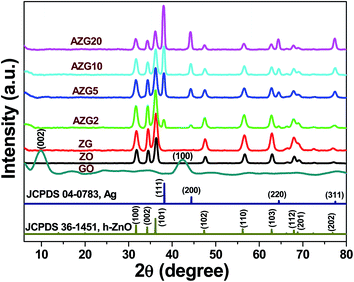 | ||
| Fig. 1 XRD patterns of ZO, ZG, AZG2, AZG5, AZG10 and AZG20 samples along with as-synthesized graphene oxide (GO). | ||
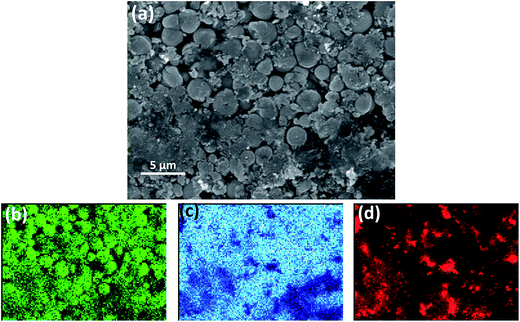 | ||
| Fig. 2 (a) FESEM image of as-prepared AZG10 nanocomposite and its corresponding elemental mapping images for (b) oxygen (c) zinc and (d) silver elements. | ||
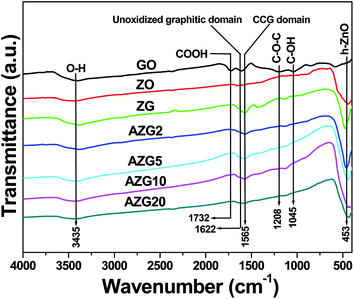 | ||
| Fig. 4 FTIR spectra of ZO, ZG, AZG2, AZG5, AZG10 and AZG20 along with as-synthesized graphene oxide (GO). | ||
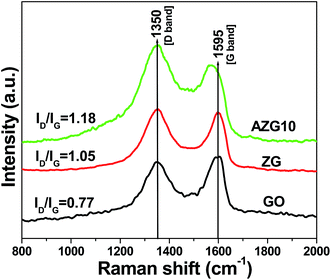 | ||
| Fig. 5 Raman spectra of GO, ZG and AZG10 samples. Respective ID/IG values are embedded in the figure. | ||
The calculated ‘D’ values of ZnO crystallites in ZO, ZG, AZG2, AZG5, AZG10, and AZG20 nanocomposites were ∼15 nm, ∼11 nm, ∼10.0 nm, ∼9.0 nm, ∼8.5 nm and ∼8 nm, respectively while the size of Ag crystallites was ∼30 nm for all the silver incorporated nanocomposites. Therefore, the crystallite size of ZnO was found to be decreased with increasing Ag loading content which is in well agreement with the reported literature.46 The small crystallite size could result in increased surface area which might contribute to enhance the antibacterial activity of AZG nanocomposite.
The TEM study of two representative samples, namely ZG and AZG10 were also performed. The TEM microstructure of ZnO–CCG (ZG) sample is shown in Fig. 3a where the hollow ZnO–CCG microsphere is clearly visible. It is worthy to note that we have already reported this observation in our previous report.41 The formation of microspheres could be happen by oriented attachment of ZnO nanoparticles through self-assembly.21 On the other hand, the Fig. 3b shows the ZnO NPs are well anchored in CCG layers. The corresponding HRTEM image of the sample as given in Fig. 3c shows the distinct lattice fringes with an interplanar distance of 0.28 nm, corresponded to (100) plane of hexagonal ZnO. This result is fully supported to XRD data (Fig. 1) of the samples. The particle size distribution of ZG is shown in the histogram (inset, Fig. 3b). From the histogram, the measured average particle size of ∼12.0 nm is obtained which corroborated with the crystallite size measured from XRD patterns (Fig. 1). The microstructure of AZG10 nanocomposite is displayed in Fig. 3d where Ag and ZnO NPs co-exist within the microsphere. However, the particle size of Ag is found to be much higher than that of ZnO nanoparticles. This observation is well supported the XRD result (Fig. 1). The nanoparticles of Ag and ZnO in AZG10 sample are clearly visible (Fig. 3e) and the lattice fringes (Fig. 3e1, e2 and f) with interplanar distances of 0.23 nm and 0.28 nm are observed from the HRTEM image of AZG10 nanocomposite. These could be indexed to the (100) plane of hexagonal ZnO and (111) plane of cubic Ag, respectively. Moreover, a wavy like lattice fringes with an average interplanar distance of 0.34 nm could confirm the existence of CCG layer as observed from the HRTEM image of ZG and AZG10 nanocomposites (Fig. 3c and f). It is also important to note that the particle size of ZnO was found to be decreased (∼9.0 nm) in AZG10 compare to ZG as evidenced from the histogram (Fig. 3e) for particle size distribution and it is in agreement with crystallite size as measured from XRD patterns (Fig. 1) of the sample. In this respect, the presence of Ag+ ions (Fig. 6) would inhibit46 the growth of hexagonal ZnO crystal during the formation of nanocomposite. However, the particles in the nano regime of Ag were much larger than ZnO. The TEM-EDX spectra of ZG and AZG10 are shown in the individual insets of Fig. 3c and f, respectively. As revealed from the EDX spectra for both the samples, the presence of C and Cu could be originated from the carbon coated Cu grid that was used for the TEM study. Another source of carbon could be the CCG that was the organic part of organic–inorganic (ZnO/Zn2+ with Ag) hybrid AZG nanocomposite. However, the existence of ZnO and CCG could show the signals for Zn and O elements (Fig. 3c and f) in ZG and AZG10 samples whereas the EDX spectrum of AZG10 (Fig. 3f) evident the existence of Ag in the sample. The observation is fully supported the XRD result (Fig. 1). A semi quantitative analysis by TEM-EDX of AZG10 nanocomposite showed the presence in atomic percentage of 86.59 ± 3.83% and 13.40 ± 3.03% Zn and Ag, respectively.
![[double bond, length as m-dash]](https://www.rsc.org/images/entities/char_e001.gif) O (aromatic),51 respectively. It is noted that the C 1s peaks with similar binding energies were also found in AZG10 (Fig. 6b). It is further noted that the intensity of the peaks for oxygen containing functional groups in AZG10 was much lower compare to precursor GO. This result implies the transformation of GO to CCG happened in the AZG10 nanocomposite.40 The strong binding energy signals of Zn 2p (Fig. 6c) was observed at 1021.9 eV and 1045 eV, could be assigned to the binding energy of Zn 2p3/2 and Zn 2p1/2, respectively.8 An energy difference of ∼23.1 eV between Zn 2p3/2 and Zn 2p1/2 binding energy levels could also confirm the existence of Zn2+ in the nanocomposite.8 On the other hand, the formation of Ag nanoparticles was also assessed by the XPS curve of AZG10 and the peaks found at 367.8 and 373.8 eV (Fig. 6d) could be assigned to Ag 3d5/2 and Ag 3d3/2, respectively.52 Moreover, the existence of Ag+ ions was also evidenced by the presence of low intensity XPS peaks at ∼371 eV and ∼378 eV.52 It is worthy to note that the presence of Ag+ ions also supported the XRD 2θ peak shifting towards lower angles in hexagonal ZnO present in AZG nanocomposites (Fig. 1). We have also calculated the Ag and Zn contents from the corresponding peak area of XPS signal for silver (Ag0 and Ag+) and zinc (Zn2+) and the contents of silver and Zn were ∼7% and ∼93%, respectively. Therefore, the experimentally measured Ag content was slightly less compare to the content that was taken (10%) from silver nitrate as the source of silver for the synthesis of AZG nanocomposite. This lower value of silver content in the nanocomposite could indicate that some silver ions removed during the purification process using ethanol and deionized water.
O (aromatic),51 respectively. It is noted that the C 1s peaks with similar binding energies were also found in AZG10 (Fig. 6b). It is further noted that the intensity of the peaks for oxygen containing functional groups in AZG10 was much lower compare to precursor GO. This result implies the transformation of GO to CCG happened in the AZG10 nanocomposite.40 The strong binding energy signals of Zn 2p (Fig. 6c) was observed at 1021.9 eV and 1045 eV, could be assigned to the binding energy of Zn 2p3/2 and Zn 2p1/2, respectively.8 An energy difference of ∼23.1 eV between Zn 2p3/2 and Zn 2p1/2 binding energy levels could also confirm the existence of Zn2+ in the nanocomposite.8 On the other hand, the formation of Ag nanoparticles was also assessed by the XPS curve of AZG10 and the peaks found at 367.8 and 373.8 eV (Fig. 6d) could be assigned to Ag 3d5/2 and Ag 3d3/2, respectively.52 Moreover, the existence of Ag+ ions was also evidenced by the presence of low intensity XPS peaks at ∼371 eV and ∼378 eV.52 It is worthy to note that the presence of Ag+ ions also supported the XRD 2θ peak shifting towards lower angles in hexagonal ZnO present in AZG nanocomposites (Fig. 1). We have also calculated the Ag and Zn contents from the corresponding peak area of XPS signal for silver (Ag0 and Ag+) and zinc (Zn2+) and the contents of silver and Zn were ∼7% and ∼93%, respectively. Therefore, the experimentally measured Ag content was slightly less compare to the content that was taken (10%) from silver nitrate as the source of silver for the synthesis of AZG nanocomposite. This lower value of silver content in the nanocomposite could indicate that some silver ions removed during the purification process using ethanol and deionized water.Based on XRD (Fig. 1), FESEM (Fig. 2), TEM (Fig. 3), FTIR (Fig. 4), Raman (Fig. 5), UV-vis (Fig. 7), TG-DTA (Fig. S1†) and XPS (Fig. 6) analyses, a probable formation mechanism and structure of AZG nanocomposite is displayed in Scheme 1.
3.2 Biomedical properties
3.3 In vitro cytotoxicity
The cytotoxicity percentage (Fig. 10) of ZO, ZG, AZG2, AZG5, AZG10 and AZG20 samples on human ovarian teratocarcinoma cell line, PA1 were evaluated by varying the concentration of samples. Each bar graph is the representation of an average of three different measurements in which composite dose-related induced cell viability loss could be found. From the result, it is clearly seen that the cell viability percentage (CVP) decreased in the order, ZG > AZG2 > AZG5 > AZG10 > AZG20 where the activity of ZO could be compared with AZG2 nanocomposite. The toxicity of ZO could attribute to the dissolution of ZnO nanoparticles and cellular uptake of the dissolute ions.21 In this work, one important observation was the improved cell viability of ZG nanocomposite. This could be due to the biocompatibility of CCG21 coupled with ZnO. The prime objective of cell viability test of ZO, ZG, AZG2, AZG5, AZG10 and AZG20 nanocomposites was to examine the action of nanocomposites on the cancer cells at 6.25 μg ml−1 sample concentration and finally, to confirm the selective antibacterial nature of AZG10 nanocomposite. Therefore, from the cell viability result, we could see that the cytotoxicity of AZG10 nanocomposite for the cancer cells was very low (∼7% only) at 10 μg ml−1. However, at 6.25 μg ml−1 sample concentration the antibacterial activity of AZG10 was found to be maximum, the cytotoxicity effect could be low. Moreover, we have seen that AZG10 nanocomposite not only showed a superior antibacterial activity but also it exhibited minimum cytotoxicity, fulfilling the objective of this work towards selective killing of bacterial cells by using Ag incorporated ZnO–CCG nanocomposite.4. Conclusion
In summary, we developed a new strategy by synthesizing highly efficient antibacterial Ag incorporated ZnO–CCG nanocomposite by low temperature solution technique without using any surfactant in the precursors. A series of Ag–ZnO–CCG (AZG) nanocomposites had been prepared by changing silver content. Without use of additional reducing agent/surfactant, silver nitrate and graphene oxide precursors were found to be reduced in situ in the reaction medium. The AZG nanocomposite synthesized from 10% Ag content in precursor showed an excellent antibacterial activity towards Gram negative and Gram positive bacteria with a very low cytotoxicity towards human ovarian teratocarcinoma cell line, PA1 at 6.25 μg ml−1 sample concentration. Therefore, Ag–ZnO–CCG nanocomposite was found to be an able antimicrobial agent that selectively kills bacteria without harming surrounding cells. This synthesis strategy could open an avenue in Ag incorporated different metal oxide–CCG nanocomposites for biomedical applications.Acknowledgements
Authors are grateful to the Director, CSIR-CGCRI, Kolkata for his kind support to publish this work. The authors, AN, SB, PS, and RB thankfully acknowledge UGC-RGNF and CSIR, Govt. of India for providing their Ph.D. research fellowships. The authors also acknowledge the help rendered by Nanostructured Materials Division, Bioceramic and Coating Division and Electron Microscopy Section for several characterizations. The work has been done as an associated research work of 12th Five Year Plan project of CSIR (No. ESC0202).References
- Z. Ma, D. Kim, A. T. Adesogan, S. Ko, K. Galvao and K. C. Jeong, ACS Appl. Mater. Interfaces, 2016, 8, 10700–10709 CAS.
- S. Huijben, A. S. Bell, D. G. Sim, D. Tomasello, N. Mideo, T. Day and A. F. Read, PLoS Pathog., 2013, 9(9), 1003578 Search PubMed.
- J. Tanwar, S. Das, Z. Fatima and S. Hameed, Interdiscip. Perspect. Infect. Dis., 2014, 2014, 541340 Search PubMed.
- F. A. Minhas, H. Rehaman, A. Yasin, Z. I. Awan and N. Ahmed, Afr. J. Biotechnol., 2013, 12(48), 6754–6760 CrossRef.
- B. Mahltig, H. Haufe and H. Böttcher, J. Mater. Chem., 2005, 15, 4385–4398 RSC.
- A. Yıldız and M. Değirmencioğlu, Bioinorg. Chem. Appl., 2015, 2015, 215354 Search PubMed.
- Q. Quan, J. Xie, H. Gao, M. Yang, F. Zhang, G. Liu, X. Lin, A. Wang, H. S. Eden, S. Lee, G. Zhang and X. Chen, Mol. Pharmaceutics, 2011, 8, 1669–1676 CrossRef CAS PubMed.
- S. Bera, M. Ghosh, M. Pal, N. Das, S. Saha, S. K. Dutta and S. Jana, RSC Adv., 2014, 4, 37479–37490 RSC.
- Y. W. Wang, A. Cao, Y. Jiang, X. Zhang, J. H. Liu, Y. Liu and H. Wang, ACS Appl. Mater. Interfaces, 2014, 6, 2791–2798 CAS.
- A. Verma and F. Stellacci, Small, 2010, 6(1), 12–21 CrossRef CAS PubMed.
- K. Elumalai and S. Velmurugan, Appl. Surf. Sci., 2015, 345, 329–336 CrossRef CAS.
- I. Matai, A. Sachdev, P. Dubey, S. U. Kumar, B. Bhushan and P. Gopinath, Colloids Surf., B, 2014, 115, 359–367 CrossRef CAS PubMed.
- M. Hans, A. Erbe, S. Mathews, Y. Chen, M. Solioz and F. Mücklich, Langmuir, 2013, 29, 16160–16166 CrossRef CAS PubMed.
- K. R. Raghupathi, R. T. Koodali and A. C. Manna, Langmuir, 2011, 27, 4020–4028 CrossRef CAS PubMed.
- H. A. Foster, I. B. Ditta, S. Varghese and A. Steele, Appl. Microbiol. Biotechnol., 2011, 90, 1847–1868 CrossRef CAS PubMed.
- Y. Zhou, Y. Kong, S. Kundu, J. D. Cirillo and H. Liang, J. Nanobiotechnol., 2012, 10, 19 CrossRef CAS PubMed.
- F. Perreault, A. F. Faria, S. Nejati and M. Elimelech, ACS Nano, 2015, 9, 7226–7236 CrossRef CAS PubMed.
- S. Prabhu and E. K. Poulose, Int. Nano Lett., 2012, 2, 32 CrossRef.
- B. Pant, P. Pokharel, A. P. Tiwari, P. S. Saud, M. Park, Z. K. Ghouri, S. Choi, S. J. Park and H. Y. Kim, Ceram. Int., 2015, 41(4), 5656–5662 CrossRef CAS.
- J. W. Rasmussen, E. Martinez, P. Louka and D. G. Wingett, Expert Opin. Drug Delivery, 2010, 7(9), 1063–1077 CrossRef CAS PubMed.
- A. Naskar, S. Bera, R. Bhattacharya, S. S. Roy and S. Jana, Polym. Adv. Technol., 2016, 27, 436–443 CrossRef CAS.
- S. Liu, T. H. Zeng, M. Hofmann, E. Burcombe, J. Wei, R. Jiang, J. Kong and Y. Chen, ACS Nano, 2011, 5(9), 6971–6980 CrossRef CAS PubMed.
- O. Akhavan and E. Ghaderi, ACS Nano, 2010, 4, 5731–5736 CrossRef CAS PubMed.
- H.-Y. Yu, G.-Y. Chen, Y.-B. Wang and J.-M. Yao, Cellulose, 2015, 22, 261–273 CrossRef CAS.
- S. Azizi, M. Ahmad, M. Mahdavi and S. Abdolmohammadi, BioResources, 2013, 8, 1841–1851 CrossRef.
- Z. Shi, J. Tang, L. Chen, C. Yan, S. Tanvir, W. A. Anderson, R. M. Berry and K. C. Tam, J. Mater. Chem. B, 2015, 3, 603–611 RSC.
- N. Drogat, R. Granet, V. Sol, A. Memmi, N. Saad, C. K. Koerkamp, P. Bressollier and P. Krausz, J. Nanopart. Res., 2011, 13, 1557–1562 CrossRef CAS.
- A. R. Allafchian and S. A. H. Jalali, J. Taiwan Inst. Chem. Eng., 2015, 57, 154–159 CrossRef CAS.
- W. P. Xu, L. C. Zhang, J. P. Li, Y. Lu, H. H. Li, Y. N. Ma, W. D. Wang and S. H. Yu, J. Mater. Chem., 2011, 21, 4593–4597 RSC.
- B. F. Leo, S. Chen, Y. Kyo, K. L. Herpoldt, N. J. Terrill, I. E. Dunlop, D. S. McPhail, M. S. Shaffer, S. Schwander, A. Gow, J. Zhang, K. F. Chung, T. D. Tetley, A. E. Porter and M. P. Ryan, Environ. Sci. Technol., 2013, 47, 11232–11240 CrossRef CAS PubMed.
- R. C. Gamez, E. T. Castellana and D. H. Russell, Langmuir, 2013, 29, 6502–6507 CrossRef CAS PubMed.
- D. O. O. Galindo, R. M. Mejia, N. Bogdanchikova and J. D. M. Morales, J. Colloid Interface Sci., 2016, 12, 1–4 CrossRef.
- M. Darroudi, A. K. Zak, M. R. Muhamad, N. M. Huang and M. Hakimi, Mater. Lett., 2012, 66, 117–120 CrossRef CAS.
- B. Yin, H. Ma, S. Wang and S. Chen, J. Phys. Chem. B, 2003, 107, 8898–8904 CrossRef CAS.
- T. Simon, C. S. Wu, J. C. Liang, C. Cheng and F. H. Ko, New J. Chem., 2016, 40, 2036–2043 RSC.
- Z. S. Pillai and P. V. Kamat, J. Phys. Chem. B, 2004, 108, 945–951 CrossRef CAS.
- P. Fageria, S. Gangopadhyay and S. Pande, RSC Adv., 2014, 4, 24962–24972 RSC.
- I. Ocsoy, M. L. Paret, M. A. Ocsoy, S. Kunwar, T. Chen, M. You and W. Tan, ACS Nano, 2013, 7(10), 8972–8980 CrossRef CAS PubMed.
- A. S. M. I. Uddin and G. S. Chung, Sens. Actuators, B, 2014, 205, 338–344 CrossRef CAS.
- S. Bera, A. Naskar, M. Pal and S. Jana, RSC Adv., 2016, 6, 36058–36068 RSC.
- S. Bera, M. Pal, A. Naskar and S. Jana, J. Alloys Compd., 2016, 669, 177–186 CrossRef CAS.
- S. Pei and H. M. Cheng, Carbon, 2012, 50, 3210–3228 CrossRef CAS.
- W. C. Hou, I. Chowdhury, D. G. Goodwin Jr, W. M. Henderson, D. H. Fairbrother, D. Bouchard and R. G. Zepp, Environ. Sci. Technol., 2015, 49, 3435–3443 CrossRef CAS PubMed.
- M. A. Raj and S. A. John, J. Phys. Chem. C, 2013, 117, 4326–4335 CAS.
- S. Bera, A. Naskar, M. Pal and S. Jana, RSC Adv., 2016, 6, 40854–40857 RSC.
- M. Ahmad, E. Ahmed, Z. L. Hong, N. R. Khalid, W. Ahmed and A. Elhissi, J. Alloys Compd., 2013, 577, 717–727 CrossRef CAS.
- A. Naskar, S. Bera, A. K. Mallik and S. Jana, Adv. Nanopart., 2016, 5, 9–17 CrossRef.
- G. Murtaza, R. Ahmad, M. S. Rashid, M. Hassan, A. Hussnain, M. A. Khan, M. E. U. Haq, M. A. Shafique and S. Riaz, Curr. Appl. Phys., 2014, 14, 176–181 CrossRef.
- X. Lv and J. Weng, Sci. Rep., 2013, 3, 3285 Search PubMed.
- S. Bera, H. Khan, I. Biswas and S. Jana, Appl. Surf. Sci., 2016, 383, 165–176 CrossRef CAS.
- J. Wang, S. Liang, L. Ma, S. Ding, X. Yu, L. Zhou and Q. Wang, CrystEngComm, 2014, 16, 399–405 RSC.
- L. Xu, D. Zhang, L. Ming, Y. Jiao and F. Chen, Phys. Chem. Chem. Phys., 2014, 16, 19358–19364 RSC.
- W. Salem, D. R. Leitner, F. G. Zingl, G. Schratter, R. Prassl, W. Goessler, J. Reidl and S. Schild, Int. J. Med. Microbiol., 2015, 305, 85–95 CrossRef CAS PubMed.
Footnote |
| † Electronic supplementary information (ESI) available. See DOI: 10.1039/c6ra14808e |
| This journal is © The Royal Society of Chemistry 2016 |

